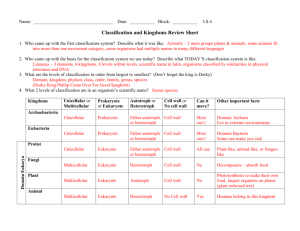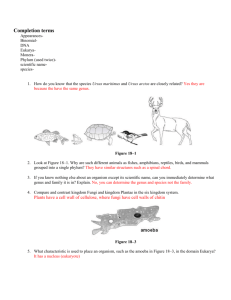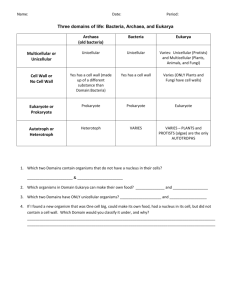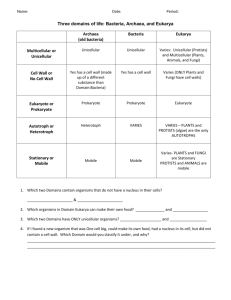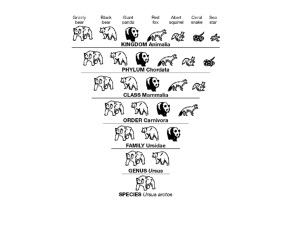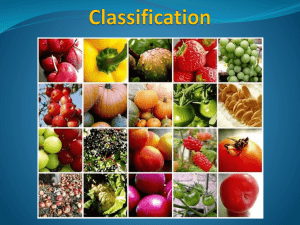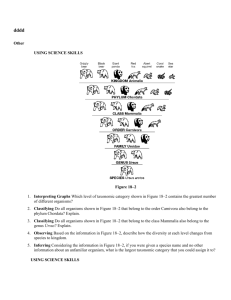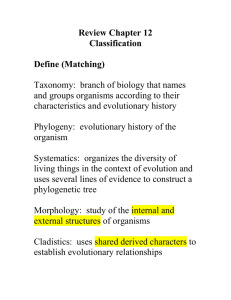Get to know the Kingdoms PPT
advertisement
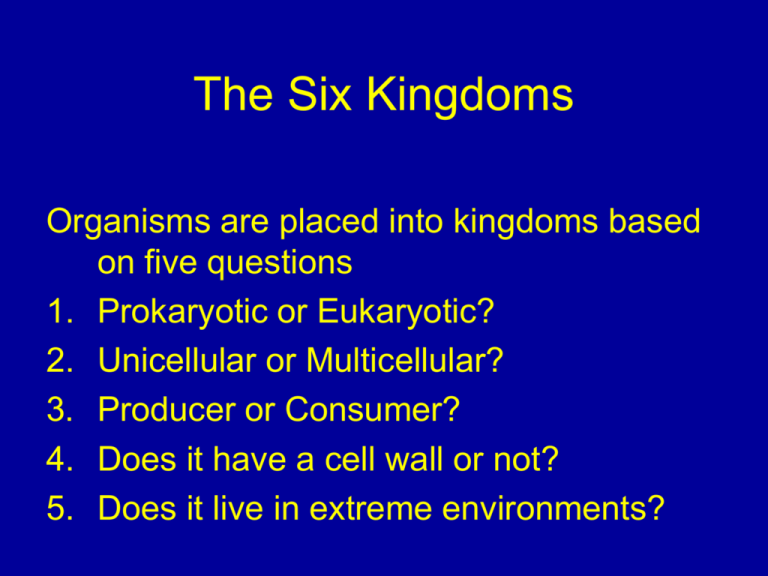
The Six Kingdoms Organisms are placed into kingdoms based on five questions 1. Prokaryotic or Eukaryotic? 2. Unicellular or Multicellular? 3. Producer or Consumer? 4. Does it have a cell wall or not? 5. Does it live in extreme environments? DNA Nucleus with DNA 1 Prokaryotic Cells Eukaryotic Cells 3 Prokaryotic Cells Eukaryotic Cells 1 2 Prokaryotic Cells Eukaryotic Cells 3 Cell 1 Membrane Prokaryotic Cells 2 DNA Eukaryotic Cells Cytoplasm 3 Cell 1 Membrane 1 2 Prokaryotic Cells 3 2 DNA Eukaryotic Cells 4 5 Cytoplasm 3 1 2 Prokaryotic Cells 3 4 5 Bacteria1 No Nucleus 2 No Organelles 3 4 Unicellular Microscopic5 Prokaryotic Cells Bacteria Cell 1 Membrane 1 2 No Nucleus No Organelles Prokaryotic Cells 2 DNA 3 4 5 Eukaryotic Cells Unicellular Microscopic 6 Cytoplasm 3 7 Organelles 1 2 Nucleus 3 Multicellular organisms Eukaryotic Cells 4 Protists 5Plants 6 Fungi 7Animals Bacteria Cell 1 Membrane Organelles 1 2 Nucleus No Nucleus No Organelles Prokaryotic Cells 2 DNA Multicellu Eukaryotic Cells Protists 5 Plants Unicellular Fungi Microscopic Cytoplasm 3 Animals • Unicellular – organisms that exist in nature as a single cell; usually microscopic • Multicellular – organisms that are more complex; usually with tissues and organs • Producers – (a. k a. autotrophs) organisms that can carry out photosynthesis to obtain energy • Consumers – (a.k.a. heterotrophs) organism that eat producers or other consumers to obtain energy Kingdom Archaebacteria 1. Prokaryote 2. Have a cell wall and some use flagella or cilia for movement 3. Unicellular 4. Autotrophic or heterotrophic 5. Asexual 6. Methanogens and halophiles – Live in very extreme environments – Only recently recognized as a separate bacteria kingdom – Can be helpful & harmful Mealor = Archea Kingdom Eubacteria 1. Prokaryote 2. Have cell walls and some use flagella or cilia for movement 3. Unicellular 4. Autotrophic or Heterotrophic 5. Asexual 6. E-coli & Streptococcus – Can be helpful & harmful – Largest of the two bacteria kingdoms & can live almost anywhere Kingdom Protista 1. Eukaryote 2. Has a Nucleus and other organelles (some have a chloroplast) 3. Mostly unicellular or some multicellular 4. Autotrophs or heterotrophs 5. Most reproduce asexually, some sexually 6. Paramecium. Amoeba, algae – – Very diverse kingdom The “Junk Drawer” Algae Kingdom Fungi 1. Eukaryote 2. Nucleus and many organelles; cell walls of chitin 3. Multicellular (except yeast) 4. All Heterotrophs– they eat! 5. Can reproduce asexually with spores or sexually 6. Examples: Mushrooms, mold, lichens – – Important decomposers Nature’s Recyclers Kingdom Plantae 1. Eukaryote 2. Nucleus and many organelles, cell walls of cellulose 3. All Multicellular 4. All are Autotrophs 5. Reproduce sexually with pollen or asexually 6. Trees, grass, ferns – Oxygen producers Kingdom Animalia 1. Eukaryote 2. Nucleus and many organelles, do not have cell walls 3. All Multicellular 4. All Heterotrophs 5. Reproduce sexually or asexually 6. Examples: insects, fish, humans – Hey! That’s You! Concept Map Section 18-3 Living Things are characterized by Eukaryotic cells and differing Important characteristics which place them in Cell wall structures such as Domain Eukarya Prokaryotic cells which is subdivided into which place them in Domain Bacteria Domain Archaea which coincides with which coincides with Kingdom Eubacteria Kingdom Archaebacteria Go to Section: Kingdom Plantae Kingdom Fungi Kingdom Protista Kingdom Animalia Figure 18-12 Key Characteristics of Kingdoms and Domains Section 18-3 Classification of Living Things DOMAIN Bacteria KINGDOM Eubacteria CELL TYPE CELL STRUCTURES NUMBER OF CELLS Eukarya Prokaryote Cell walls with peptidoglyc an Unicellular MODE OF NUTRITION Autotroph/ heterotroph EXAMPLES Strep., E- coli Go to Section: Archaea Protist web site Figure 18-12 Key Characteristics of Kingdoms and Domains Section 18-3 Classification of Living Things DOMAIN Bacteria Archaea KINGDOM Eubacteria Archaebacteria CELL TYPE CELL STRUCTURES NUMBER OF CELLS Eukarya Prokaryote Prokaryote Cell walls with peptidoglyc an Cell walls without peptidoglycan Unicellular Unicellular MODE OF NUTRITION Autotroph/ heterotroph Autotroph or heterotroph EXAMPLES Strep., E- coli X-tremophiles Go to Section: Protist web site Figure 18-12 Key Characteristics of Kingdoms and Domains Section 18-3 Classification of Living Things DOMAIN Bacteria Archaea KINGDOM Eubacteria Archaebacteria CELL TYPE CELL STRUCTURES NUMBER OF CELLS Eukarya Prokaryote Prokaryote Eukaryote Cell walls with peptidoglyc an Cell walls without peptidoglycan Cell walls of cellulose in some; some have chloroplasts Most unicellular; some colonial; some multicellular Unicellular Unicellular MODE OF NUTRITION Autotroph/ heterotroph Autotroph or heterotroph EXAMPLES Strep., E- coli X-tremophiles Go to Section: Protista Autotroph or heterotroph Amoeba, Paramecium, slime molds, giant kelp Protist web site Figure 18-12 Key Characteristics of Kingdoms and Domains Section 18-3 Classification of Living Things DOMAIN Bacteria Archaea KINGDOM Eubacteria Archaebacteria CELL TYPE CELL STRUCTURES NUMBER OF CELLS Eukarya Fungi Prokaryote Prokaryote Eukaryote Cell walls with peptidoglyc an Cell walls without peptidoglycan Cell walls of Cell walls of cellulose in chitin some; some have chloroplasts Most unicellular; some colonial; some multicellular Unicellular Unicellular MODE OF NUTRITION Autotroph/ heterotroph Autotroph or heterotroph EXAMPLES Strep., E- coli X-tremophiles Go to Section: Protista Autotroph or heterotroph Eukaryote Most multicellular; some unicellular Heterotroph Mushrooms, Amoeba, yeasts Paramecium, slime molds, giant kelp Protist web site Figure 18-12 Key Characteristics of Kingdoms and Domains Section 18-3 Classification of Living Things DOMAIN Bacteria Archaea KINGDOM Eubacteria Archaebacteria CELL TYPE CELL STRUCTURES NUMBER OF CELLS Eukarya Fungi Prokaryote Prokaryote Eukaryote Cell walls with peptidoglyc an Cell walls without peptidoglycan Cell walls of Cell walls of cellulose in chitin some; some have chloroplasts Most unicellular; some colonial; some multicellular Unicellular Unicellular MODE OF NUTRITION Autotroph/ heterotroph Autotroph or heterotroph EXAMPLES Strep., E- coli X-tremophiles Go to Section: Protista Autotroph or heterotroph Eukaryote Plantae Eukaryote Cell walls of cellulose; chloroplasts Most multicellular; some unicellular Multicellular Heterotroph Autotroph Mushrooms, Amoeba, yeasts Paramecium, slime molds, giant kelp Protist web site Mosses, ferns, flowering plants Figure 18-12 Key Characteristics of Kingdoms and Domains Section 18-3 Classification of Living Things DOMAIN Bacteria Archaea KINGDOM Eubacteria Archaebacteria CELL TYPE CELL STRUCTURES NUMBER OF CELLS Eukarya Fungi Prokaryote Prokaryote Eukaryote Cell walls with peptidoglyc an Cell walls without peptidoglycan Cell walls of Cell walls of cellulose in chitin some; some have chloroplasts Most unicellular; some colonial; some multicellular Unicellular Unicellular MODE OF NUTRITION Autotroph/ heterotroph Autotroph or heterotroph EXAMPLES Strep., E- coli X-tremophiles Go to Section: Protista Autotroph or heterotroph Eukaryote Plantae Eukaryote Cell walls of cellulose; chloroplasts Most multicellular; some unicellular Multicellular Heterotroph Autotroph Mushrooms, Amoeba, yeasts Paramecium, slime molds, giant kelp Protist web site Animalia Eukaryote No cell walls or chloroplasts Multicellular Mosses, ferns, flowering plants Heterotroph Sponges, worms, insects, fishes, mammals
